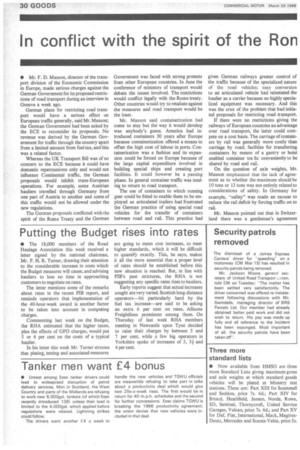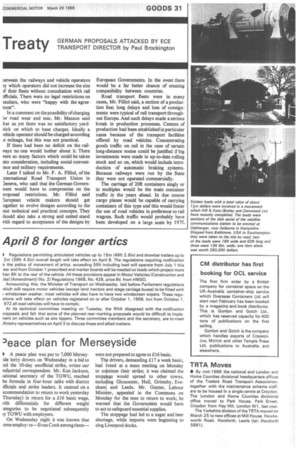In conflict with the spirit of the Ron Treaty
Page 32

Page 33

If you've noticed an error in this article please click here to report it so we can fix it.
• Mr. F. D. Masson, director of the transport division of the Economic Commission in Europe, made serious charges against the German Government for its proposed restrictions of road transport during an interview in Geneva a week ago.
German plans for restricting road transport would have a serious effect on European traffic generally, said Mr. Masson; the German Government had been asked by the ECE to reconsider its proposals. No revenue was derived by the German Government for traffic through the country apart from a limited amount from fuel tax, and this was a related factor.
Whereas the UK Transport Bill was of no concern to the ECE because it could have domestic repercussions only and would not influence Continental traffic, the German proposals would inhibit trans-European operations. For example, some Austrian hauliers travelled through Germany from one part of Austria to another and some of this traffic would not be allowed under the new regulations.
The German proposals conflicted with the spirit of the Rome Treaty and the German Government was faced with strong protests from other European countries. In June the conference of ministers of transport would debate the issues involved. The restrictions would conflict legally with the Rome treaty. Other countries would try to retaliate against the measures and road transport would be the loser.
Mr. Masson said containerization had come to stay but the way it would develop was anybody's guess. America had introduced containers 30 years after Europe because containerization offered a means to offset the high cost of labour in ports. Containerization was a fashion and its expansion could be forced on Europe because of the large capital expenditure involved in building special ships and creating port facilities. It could however be a passing phase. In general container traffic was tending to return to road transport.
The use of containers to which running gear could be fitted to enable them to be employed as articulated trailers had frustrated the German practice of using special road vehicles for the transfer of containers between road and rail. This practice had given German railways greater control of the traffic because of the specialized nature of the road vehicles; easy conversion to an articulated vehicle had reinstated the haulier as a carrier because no highly specialized equipment was necessary. And this was the crux of the problem that had initiated proposals for restricting road transport.
If there were no restrictions giving the railways of European countries an advantage over road transport, the latter could compete on a cost basis. The carriage of containers by rail was generally more costly than carriage by road; facilities for transferring containers by means of a gantry or hoist enabled container tra fic conveniently to be shared by road and rail.
On the question of axle weights, Mr. Masson emphasized that the lack of agreement as to whether the maximum should be 10 tons or 13 tons was not entirely related to considerations of safety. In Germany for example, -safety" was made an excuse to reduce the rail deficit by forcing traffic on to rail.
Mr. Masson pointed out that in Switzerland there was a gentleman's agreement
)etween the railways and vehicle operators )y which operators did not increase the size )f their fleets without consultation with rail 3fficials. There were no legal restrictions on unifiers, who were "happy with the agreenent".
In a comment on the possibility ofcharging 'or road wear and tear, Mr. Masson said hat as yet there was no satisfactory yard;tick on which to base charges. Ideally a Thiele operator should be charged according o mileage, but this was not practical.
If there had been no deficit on the railvays no one would bother about it. There were so many factors which could be taken nto consideration, including social convenimce and military requirernents.
Later I talked to Mr. F. A. Filliol, of the ntemational Road Transport Union in 3eneva, who said that the German Governneat would have to compromise on the noposed restrictions. Mr. Filliol said 3.uropean vehicle makers should get ogether to evolve designs according to the >est technical and practical concepts. They ;hould also take a strong and united stand with regard to acceptance of the designs by European Governments. In the event there would be a far better chance of creating compatibility between countries.
Road transport fleets were in many cases, Mr. Filliol said, a section of a production line; long delays and loss of consignments were typical of rail transport throughout Europe. And such delays made a serious break in production processes. Centres of production had been established in particular cases because of the transport facilities offered by road vehicles. Concentrating goods traffic on rail in the case of certain long-distance routes could be justified if big investments were made in up-to-date rolling stock and so on, which would include introduction of automatic braking systems. Because railways were run by the State they were not operated commercially.
The carriage of 20ft containers singly or in multiples would be the main container traffic in the years ahead. In due course cargo planes would be capable of carrying containers of this type and this would foster the use of road vehicles in preference to rail wagons. Such traffic would probably have been developed on a large scale by 1975.
























































































































